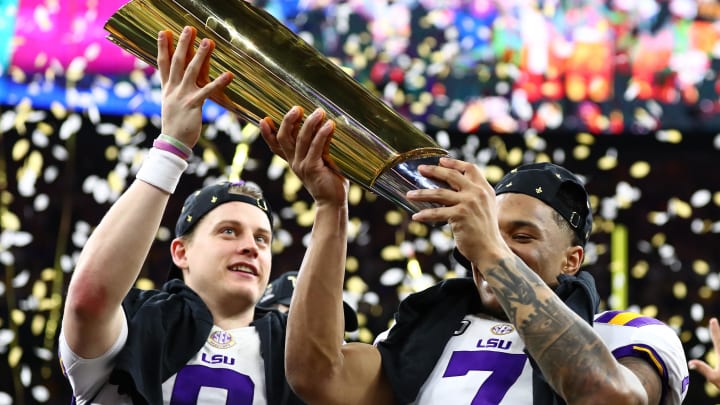Over 400,000 Former DI Athletes Eligible for NIL Backpay, How Much Can You Make?

Over the past week, several former Division I athlete friends have contacted me to inquire about the House v. NCAA settlement proposal. One thing that I have noticed, to no fault of any former athlete, is a lack of understanding of how much money athletes are entitled to and confusion regarding who is eligible to receive NIL backpay compensation. I am writing this to demystify the proposed settlement payout for the general public and, more importantly, help those in the plaintiff class receive the money they are rightfully owed.
House v. NCAA has dominated offseason headlines for its magnitude in changing the structure of collegiate sports. A proposed settlement between the NCAA and plaintiffs has two features: the first is a backward-facing agreement slated to pay 2.576 billion dollars (before attorney fees) in NIL backpay to athletes who competed in NCAA Division I sports from 2016 to 2024. Put simply, former Power 5 revenue athletes are entitled to life-changing money, sometimes reaching six and even seven-figure payouts at the high end –– for those outside of the Power 5, and even outside of revenue sports, serious money is available in varying amounts.
Separate from the backward-facing payout is a forward-facing remedy that looks to enshrine a revenue-sharing regime between institutions and their athletes for the use of players’ NIL on game broadcasts, as well as limit the ability of NIL collectives to function as freely as they do in modern collegiate athletics. The details of the forward-facing component are not important for the scope of this article, but what is imperative to know is that the forward-facing remedies are novel and at least facially appear to run a high risk of violating tenants of antitrust law. For this reason, the next step of the House v. NCAA settlement, judicial approval, is not a shoo-in and could potentially jeopardize the timely payout of settlement funds to athletes and prolong litigation.
Assuming that Judge Claudia Wilken approves the settlement proposal, significant efforts will be taken to notify the plaintiff class about their eligibility to receive NIL backpay; according to the Motion for Settlement, “The proposed notice program provides individual direct notice to all reasonably identifiable members of the Damages Settlement Classes via email or postcard notice, along with a robust social media notice program, dedicated website, and toll-free telephone line where Settlement Class Members can learn more about their rights and options pursuant to the terms of the Settlement.”
For former Power 5 revenue athletes, collecting their settlement payout will be relatively streamlined. The settlement will follow Dr. Rascher's formula, which calculates the lost earnings of athletes from not receiving broadcasting NIL payments (BNIL) and royalties from video game payouts. Members of this class will still be responsible for submitting a claim for lost NIL opportunities, which will be discussed later in the breakdown of each part of the settlement.
For the roughly 400,000 eligible student-athletes who did not play highly visible Power 5 revenue sports, there is still money available for damages related to video game payouts and other NIL earning avenues; however, to receive compensation, these athletes will have to submit their own claims; “Settlement Class Members will have the ability to electronically submit claims for damages where required. That includes claims for lost opportunity damages not in Dr. Rascher’s deals database and claims by members of the Additional Sports Class for videogame damages and additional compensation for athletic participation damages.”
There are three components of NIL Backpay: 1) Broadcast NIL, 2) Videogame NIL Fund, and 3) Lost NIL Opportunities. Claims in these categories stack and can entitle high-profile athletes to hefty payouts.
Broadcast NIL (BNIL): Broadcast NIL Funds are primarily reserved for athletes who received full athletic scholarships and played football, men’s basketball, and women’s basketball at the Power 5 level between Fall 2016 and Spring 2023. According to the Drescher Report, athletes who competed in Non-Power 5 conferences will not be entitled to BNIL damages because “The broadcasting contracts for non-Power Five conferences have, in general, materially smaller revenues.”
This is the largest damage pool, with roughly $1,815,000,000 in funds to be dispersed. The deals will be based on a split of conference broadcasting revenue — 75% of each conference’s respective media deal settlement value will go to men’s football athletes, 15% to men’s basketball, and 5% to women’s basketball.
All athletes will be entitled to a minimum annual payout based on their sport and what year(s) they played. These minimum payouts will distribute $1,215,000,000 of the total BNIL fund. $570,000,000 will be allocated to Power 5 revenue athletes for “athletic services.” Performance metrics like recruiting stars, snap count, and win production will entitle them to enhanced shares of this additional $570,000,000 pool in proportion to their respective team’s revenue.
According to the settlement proposal, approximately 19,000 male Power 5 athletes will qualify and receive an average of $91,000 from BNIL payments, ranging between $15,000 to $280,000 in total BNIL compensation.
The BNIL payments for the 3,000 women’s Power 5 basketball players will average approximately $23,000 and range between $3,000 and $52,000, once again, depending on team revenue, years played, and performance metrics.
As a careful reader may have noticed, $30,000,000 remains in the total BNIL fund. The money is earmarked for “athletic services” outside of Power 5. According to the settlement, “Athlete claimants will receive an expanded share if they play certain sports at schools outside of the Power Five, where their school’s team is among the highest revenue-generating.” Several carveouts, listed below, aim to provide specific players with more compensation based upon heightened notoriety of their sport and conference:
Power 5 baseball: Average compensation of $400
Top Non-Power Five Football: AAC, Mountain West, and BYU players will receive an average compensation of $1,400
Big East Basketball: Average compensation of $6,700.
Top Non-Power Five Men’s Basketball: AAC, A10, Mountain West, and Gonzaga players will receive an average compensation of $2,400.
Top Non-Power Five Women’s Basketball: Athletes who competed in the AAC, Big East, and Gonzaga will receive an average compensation of $300.
For the vast majority of the 400,000+ former Division I student-athletes in the plaintiff class who did not play basketball or FBS Football, this is where they (or should I say we) can collect damages. The remainder of the $30,000,000 Non-Power 5 athletic services fund is open to Division I student-athletes who received full or partial scholarships during the relevant time period and who submit a claim. Successful claims from all other athletes are approximated to earn an average of $50.
Walk-ons are not eligible for compensation for any BNIL claims.
Video Game NIL Fund: The Video Game NIL fund will not be solely reserved for Power 5 athletes. Those eligible for Video Game NIL compensation will include the previous Power 5 male athletes, non-Power Five Division I men’s basketball players, and all FBS football players (scholarship athletes only). FCS football players and any service academy athlete will not be eligible to recover in this class. Additionally, no football players will be able to recover for the upcoming season as the new EA Sports College Football ‘25 Game has restored third-party NIL payments for video games.
This leaves us with a large recovery pool of 44,000 athletes entitled to proportionately split $71,500,000 in video game NIL compensation. The compensation is based on the year(s) the athlete was an active member of an eligible roster. According to the Rascher Declaration, these payouts vary significantly by year. For football, the per-year pay ranges from $455 for the 2015-16 season to $503 for the 2023-24 season. For basketball, per-year pay ranges have a larger variance from $286 for the 2015-16 season all the way to $975 for the 2024-25 season.
Lost NIL Opportunities: The last category of the settlement fund is for “Lost Opportunities,” and settlements in this class can range from $1 to $1,859,000, depending on the NIL value athletes can prove. The total settlement fund for Lost Opportunities is $89,500,000. Power 5 male athletes will earn an average of $17,000 from this fund, ranging between $1 and $800,000. For women’s Power 5 basketball, an average of $8,500 is estimated, ranging between $1 to $300,000. Even for Power 5 athletes, a claim is required to secure Lost NIL opportunity compensation.
For Non-Power 5 athletes, Lost NIL Opportunities are available. Those athletes who submit successful claims (the settlement approximates 6,000 successful claimants) are entitled to damages of anywhere between $1 and $1,859,000. It is likely that the high-end outlier significantly raises the average payouts.
